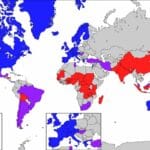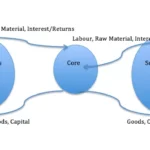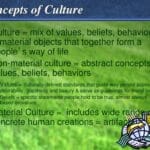Embark on a journey into the fascinating world of cultural traits—the shared ideas, beliefs, and practices that shape societies and individual identities. This article delves into what cultural traits are, how they evolve, and their profound impact on our lives. From the tools we use to the values we cherish, cultural traits are the building blocks of our diverse world.
Decoding Cultural Traits
Cultural traits are the fundamental elements that define a society. They encompass the tangible and intangible aspects of human experience, shaping how we interact, what we believe, and how we express ourselves. Think of them as the unique ingredients that flavor the diverse cultures across the globe.
What Exactly Are Cultural Traits?
Cultural traits are the shared habits, ideas, and objects that bind a group of people together. These can range from the clothes we wear and the food we eat to the languages we speak and the stories we tell. Experts often categorize them into three main types:
| Type of Trait | Description | Examples |
|---|---|---|
| Artifacts | Physical objects created by a culture | Clothing, tools, art, buildings |
| Sociofacts | Customs, norms, and social structures | Marriage traditions, greetings, family dynamics |
| Mentifacts | Beliefs, values, ideas, and knowledge | Religious beliefs, morals, language |
These traits are transmitted across generations through a process called enculturation, much like learning a family recipe. They can also spread between groups through diffusion, similar to sharing recipes with friends. The cleavages of social class can significantly influence which cultural traits are adopted and how they are expressed.
The Ever-Shifting Nature of Culture
Cultural traits are not static; they constantly evolve. Factors like the environment, technological advancements, and interactions with other cultures contribute to this ongoing transformation. Globalization, with its increased interconnectedness, has accelerated this process. Some researchers suggest that this could lead to cultural homogenization, while others argue it may strengthen unique cultural identities in response. This ongoing debate is central to understanding the future of cultural diversity.
Why Cultural Traits Matter
Cultural traits are far from mere curiosities. They have a profound influence on how we perceive the world, form relationships, and navigate social situations. Understanding these traits is crucial for promoting cross-cultural understanding and appreciating the rich tapestry of human experience. In a world increasingly shaped by globalization, recognizing and respecting cultural differences is more vital than ever. Frameworks like Geert Hofstede’s cultural dimensions theory offer tools for comparing cultures, but they must be used cautiously, acknowledging that cultures are dynamic and diverse. Each individual within a culture brings their unique perspective and experiences, contributing to the ever-evolving nature of cultural expression. The clerestory glass in many historical buildings often reflects the dominant cultural values and artistic styles of the time.
The 7 Pillars of Culture: How Shared Values and Beliefs Define Us
Culture is more than just the sum of its parts. It’s a complex system with key characteristics that drive its dynamism and influence. These seven characteristics are fundamental to understanding how cultures function and evolve:
Learned, Not Inherited: Culture is acquired through socialization, not through genes. We learn from our families, communities, and the world around us, constantly absorbing and adapting to the cultural norms and values of our environment.
Shared, Not Solitary: Culture is a collective experience, binding individuals together through shared symbols, rituals, and understandings. This shared cultural context enables communication and cooperation within a group.
Symbolic, Not Literal: Cultures use symbols—language, gestures, objects—to represent abstract ideas and values. These symbols provide shortcuts to shared meanings, enriching communication and reinforcing cultural identity.
Integrated, Not Isolated: The various aspects of a culture—its beliefs, customs, technologies—are interconnected. A change in one area can likely trigger changes in others, demonstrating the dynamic and integrated nature of cultural systems.
Adaptive, Not Static: Cultures are constantly evolving to adapt to changing circumstances, whether environmental shifts, technological innovations, or interactions with other cultures. This adaptability is essential for cultural survival and continuity.
Influential, Not Passive: Culture exerts a powerful influence on our thoughts, feelings, and actions. It shapes our perceptions of the world, guides our behaviors, and informs our decision-making processes.
Diverse, Not Uniform: Human cultures vary enormously, reflecting a spectrum of human experiences, adaptations, and creative expressions. This diversity is a vital source of innovation and resilience in a changing world.
Cultural Traits in Human Geography: Shaping Societies and Landscapes
In human geography, cultural traits are the specific characteristics that distinguish one group of people from another. These traits, encompassing both material and non-material elements, shape a group’s identity and influence how they interact with their environment.
Material and Non-Material Culture
Material Culture: These are the physical objects created and used by a culture—clothing, tools, architecture, and art. Material culture reflects a group’s technological advancements, artistic sensibilities, and adaptation to their environment.
Non-Material Culture: This includes the intangible aspects of a culture, such as beliefs, values, norms, language, and social institutions. Non-material culture shapes social interactions, moral codes, and worldviews.
Drivers of Cultural Change
Cultures are not fixed; they are constantly in flux. Several key processes drive this evolution:
Social Learning: Traits are transmitted across generations through observation, imitation, and formal education.
Diffusion: Cultural exchange through migration, trade, media, and other interactions leads to the spread of traits between groups.
Innovation: New ideas, technologies, and practices emerge within a culture, leading to novel forms of expression and adaptation.
Adaptation: Existing traits are modified to better suit changing social or environmental conditions.
Culture and the Environment
Human geography emphasizes the dynamic relationship between culture and the environment. Cultural traits influence how people interact with and modify their surroundings, while the environment, in turn, can shape cultural development. This continuous interplay creates the diverse cultural landscapes we see across the globe.
Beyond “Cultural Traits”: Exploring the Nuances of Shared Practices
Cultural traits are the distinctive qualities that define a group’s identity. While “cultural trait” is a standard term, several synonyms offer nuanced perspectives on these shared attributes:
Folkway: Everyday customs and habits, often taken for granted, that guide social interactions (e.g., shaking hands).
More (pronounced “mor-ay”): Deeply ingrained norms with strong moral significance, violations of which can result in serious social consequences.
Custom: Established patterns of behavior within a culture, often associated with specific events or rituals.
Practice: The active performance of customs, rituals, or routines that embody cultural values.
Tradition: Customs and beliefs passed down through generations, connecting people to their past and providing a sense of continuity.
Norm: Socially accepted standards of behavior that regulate interactions and maintain social order.
Value: Core principles and ideals that guide behavior and shape a culture’s worldview.
Belief: Accepted truths about the world, often related to religion, philosophy, or cosmology.
Characteristic: A distinguishing feature or quality that sets a culture apart.
These terms, while related, provide different shades of meaning. Choosing the appropriate synonym allows for a clearer and more precise understanding of the specific cultural element being discussed.
- Senior at What Age: Benefits & Eligibility Guide - March 29, 2025
- Unlocking Senior Benefits: How Old is a Senior? Your Complete Guide - March 29, 2025
- Master Russian Politeness:A Guide to Saying Please - March 29, 2025

















1 thought on “Understanding Cultural Traits: A Deep Dive into the Building Blocks of Society”
Comments are closed.